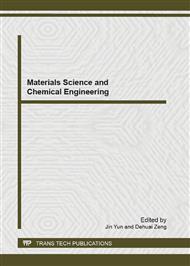p.34
p.40
p.46
p.51
p.57
p.63
p.68
p.72
p.77
Effect of Compatibilizers on Mechanical and Thermal Properties of High Density Polyethylene Filled with Bio-Filler from Eggshell
Abstract:
In this research work, the effect of compatibilizers on mechanical and thermal properties of ESP/HDPE composites was investigated. High density polyethylene grafted with maleic anhydride (HDPE-g-MA) and ethylene propylene rubber grafted with maleic anhydride (EPR-g-MA) were used to compatibilize the ESP/HDPE composites. The ESP/HDPE composite with and without the compatibilizes was prepared at 20 wt.% ESP. The volume average particle size of ESP was 20.35 µm. The compatibilized HDPE composites were prepared at 2, 5, 8 and 10 wt.% of HDPE-g-MA and at 2, 5, 8 and 10 wt.% of EPR-g-MA, as well. It was found that ultimate stress, yield strength, and elongation at break of the ESP/HDPE composites prepared with HDPE-g-MA increased with increasing HDPE-g-MA content. In addition, Young’s modulus was maximum at 8 wt.% HDPE-g-MA. The composites filled with HDPE-g-MA had improved impact strength with increasing HDPE-g-MA content. On the other hand, the composites with EPR-g-MA showed a decrease in tensile properties and impact strength when increasing EPR-g-MA content. The impact strength of the HDPE composites compatibilized with EPR-g-MA decreased with increasing EPR-g-MA content. In addition, degree of crystallinity of the composites with EPR-g-MA was higher than that of the composite with HDPE-g-MA. Furthermore, compatibilizing ESP/HDPE composites with either HDPE-g-MA or EPR-g-MA did not influence HDPE and ESP decomposition temperatures, HDPE melting temperature and HDPE crystallization temperature.
Info:
Periodical:
Pages:
57-62
Citation:
Online since:
May 2013
Keywords:
Price:
Сopyright:
© 2013 Trans Tech Publications Ltd. All Rights Reserved
Share:
Citation:


